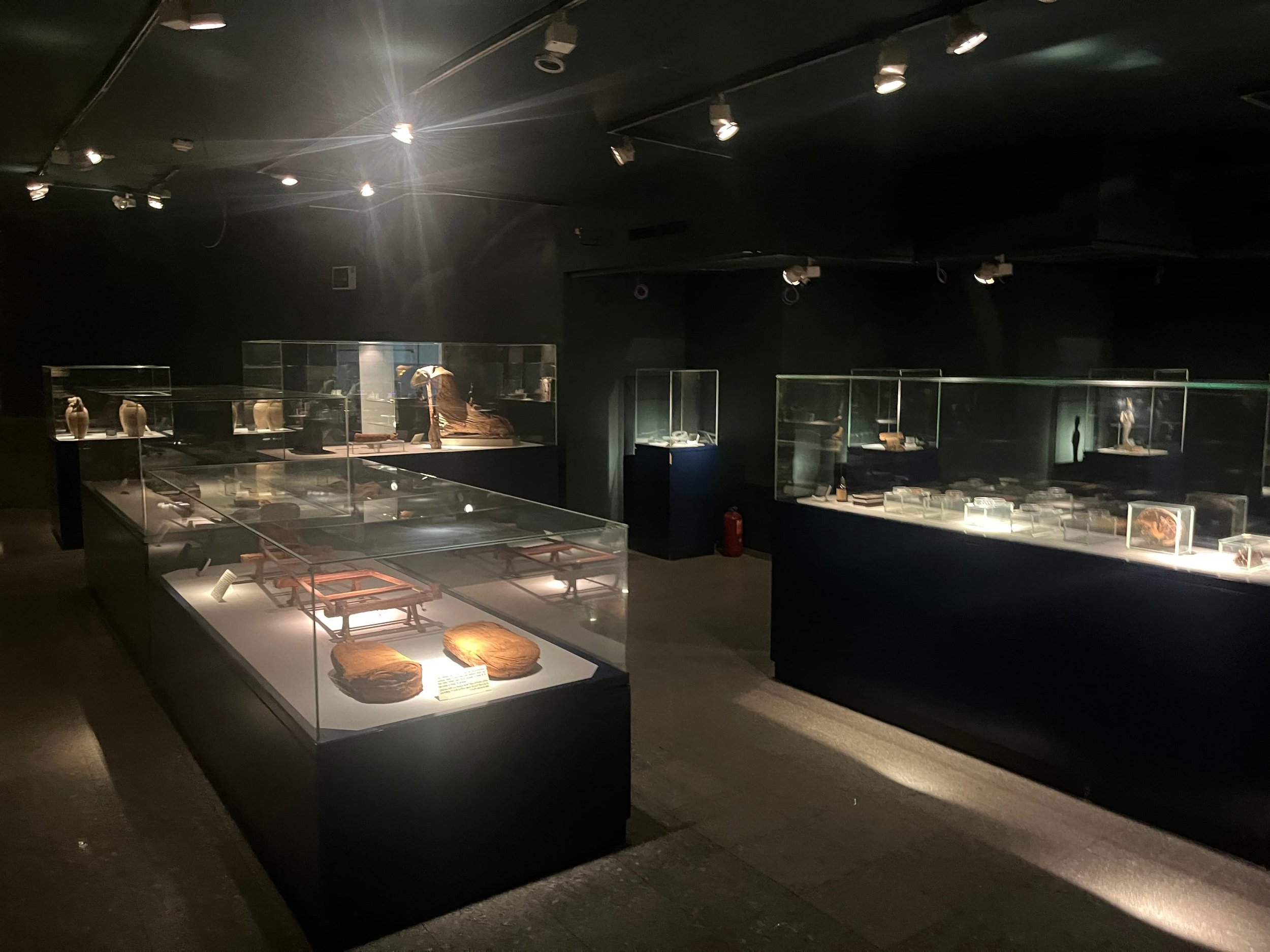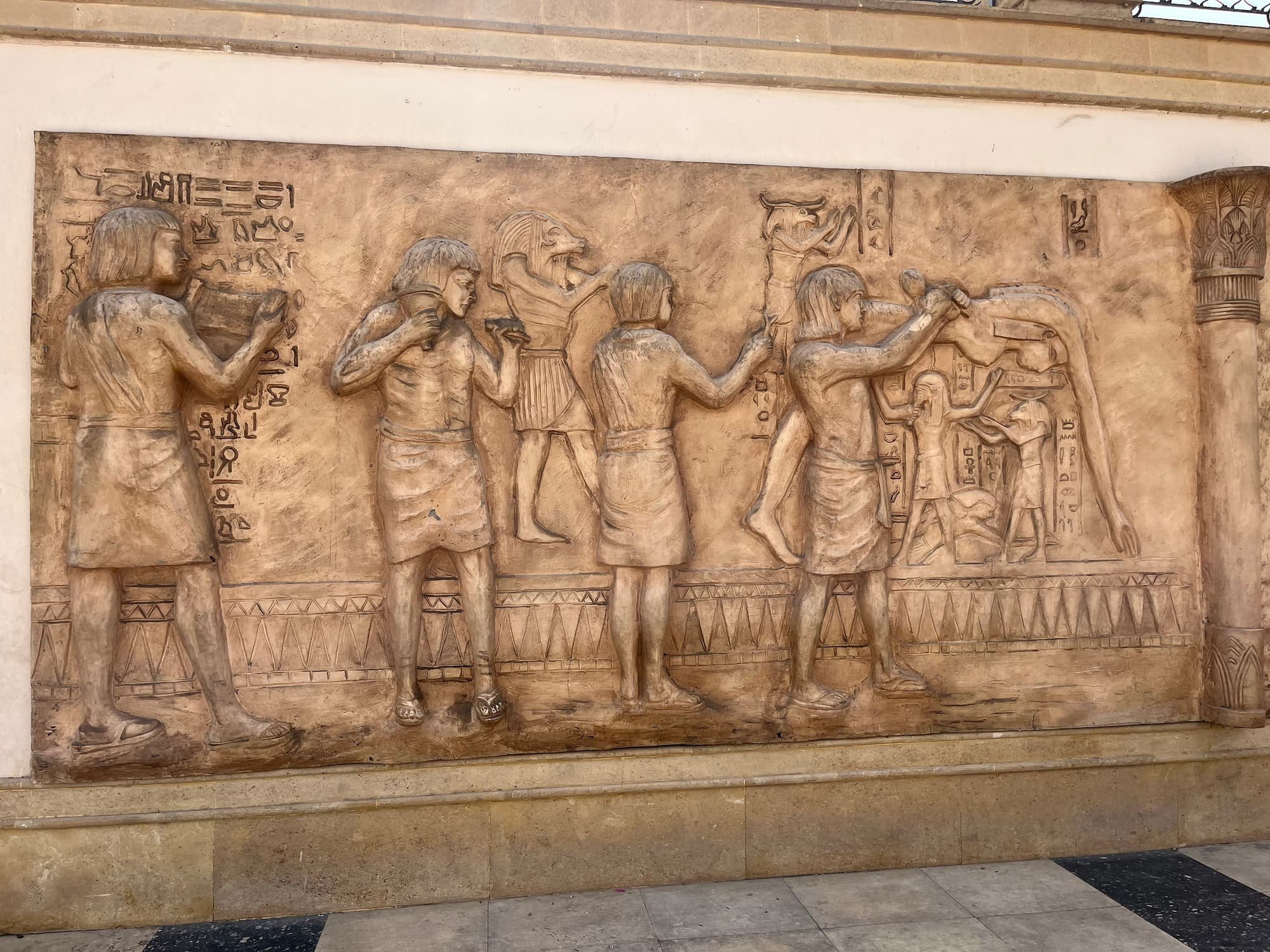Visiting the Mummification Museum in Luxor, Egypt.
Are you ready to learn the art of mummification?
One thing that I noticed that the Egyptians do very well, is proudly showcase their ancient past - in some very fun ways!
The mummification Museum in Luxor ticks this box and offers some juicy surprises!
Most people visit Luxor to visit the famous temples, or the well preserved tombs, however, the museums should not be overlooked during your adventure down the Nile.
The Mummification Museum on the East Bank of the Nile may be small, but it offers a fascinating collection of mummy exhibits which will deepen your understanding of the mummification process in a short visit.
You can expect to see mummies of humans, along with the animals which were worshipped by the ancient Egyptians.
My favourite was the crocodile!
If you can’t decide whether you want to pay a visit to the museum, or are looking for a cheap activity to fill some of your Luxor itinerary, then this blog will give you all the information you need to make up your mind.
A mummified ram takes the prize of most impressive mummy on display.
An introduction to the Mummification Museum.
The Mummification Museum is a small museum dedicated ancient Egyptian mummification, which is a fascinating aspect of the vast history of Egypt which draws intrigue around the globe.
The museum consists of a combination of original artefacts, curated exhibits, and some very juicy mummies, all of which illustrate the full mummification process.
Its doors first opened in 1997 on the banks of the Nile, and it has narrated the story of mummification ever since with multilingual plaques and beautiful art.
My personal thoughts on the museum following my visit.
Compared to the Egyptian Museum in Cairo and the Nubian Museum in Aswan, it was small in size, however, its ambiance was perfect!
I found the dimmed lights helped to brighten up the exhibits to make them easier to read, and helped to capture some great ancient shots.
It is one large room with many different sections and it is wonderfully curated.
I visited when the temperature outside was over 40°, so the air conditioning within the museum was a welcome break from the heat.
I spent around 30 minutes exploring the place and didn’t feel rushed by any staff - this made it a much nicer experience.
This museum is the perfect cheap activity to help to fill your Egypt itinerary up, while giving you a break from the heat of exploring the tombs and temples.
Walking between the different sites in Luxor can be difficult in the hotter months, so booking a private tour makes your day more comfortable with private transport between the different places.
The museum is well signposted on the main Corniche.
Where is the Mummification Museum located?
The Mummification Museum is located in Luxor, Egypt, on the Corniche in front of the Mina Palace Hotel.
It is situated to the north of the Luxor Temple overlooking the Nile River on the East Bank.
It is within walking distance of most hotels on the East Bank side of the city, however, if you are staying on the West Bank, you will need to travel by taxi/boat.
Consider travelling by taxi if you are visiting in summer months as the temperatures get inhumane.
As with all of the cities in Egypt, it is best to plan your transport options in advance.
The corniche in Luxor alongside the River NIle.
The stairs leading down to the small museum.
Mummification Museum Entrance Fee & Opening times.
The entrance fees as of September 2023 are:
Visitors = 140 EGP (£3.55).
Students = 70 EGP (£1.75).
Opening times:
Daily from 9am - 1pm & 5pm - 8pm.
Entrance fees are displayed in English and Arabic on the display boards.
Understanding the Significance of Mummification in Ancient Egyptian Beliefs.
Walking around the museum is like stepping into a time machine back to ancient times, as it becomes clear why the whole mummification process was so important to the people of that time.
The ancient Egyptians strongly believed in a complex journey in their afterlife, hence the burial pyramids and necropolises.
They believed that the only way they would experience this, was if the body was recognisable.
The meticulous wrapping of the body in linen bandages, often soaked in resins and anointed with oils, served as a barrier against decay, preserving the delicate features and individual characteristics of the deceased.
The deceased's soul, or "ba," would embark on a perilous passage through the underworld to reunite with their physical body, or "ka." To ensure this reunion and the eternal existence of the individual, the process of mummification was paramount.
As you explore into the museum's exhibits, you'll encounter real human and animal mummified bodies, which display the mastery of the Egyptian’s preservation techniques!
The museum is curated immaculately.
The ancient art is interesting to look at.
The preservation process of important people in Ancient Egypt.
For thousands of years, the ancient Egyptians mummified their dead, and removed their organs and wrapped the body to preserve it. It is said to have taken around 70 days to complete the process and involved rituals.
The museum provides exhibits and information Boards to explain the process visually in a beautiful way.
The mummification process had several stages, including:
Preparation.
The body was washed and cleansed of dirt and impurities.
Internal organ removal.
The brain was removed through the nose, and the internal organs were removed and placed in canopic jars.
Drying.
The body was dried with natron, a naturally occurring salt that helps to absorb moisture.
Anatomical treatment.
The body was filled with aromatic resins and herbs to preserve its shape and prevent decay.
Bandaging and wrapping.
The body was wrapped in linen bandages, which were typically soaked in resins and anointed with fragrant oils.
Preservation rituals.
Priests performed various rituals to ensure the deceased's journey to the afterlife was blessed and protected.
Final encasement.
The mummified body was placed in a beautifully decorated coffin and then inside a sarcophagus.
One of the most famous mummies on display is the well-preserved mummy of a 21st-dynasty high priest of Amun, Maserharti.
As you can see below, he is a fine example of how well the Egyptians completed the mummification process.
A juicy mummy of a former high priest on display.
Which animals were sacred to the ancient Egyptians?
My favourite part of my trip to the Mummification Museum was looking at the different animal mummies.
I had seen a vast amount of human mummies in films and on the internet, however, I had never seen a crunched up baboon mummy - that was certainly a first!
Other well known animals which are displayed in a mummified state on site are:
Cats.
It is well known that Cats were held in high regard in ancient Egypt as sacred beings associated with the goddess Bastet, who embodied domesticity, protection, and motherhood. Cat mummies were often found in temples and homes, and they were believed to act as intermediaries between the human and divine realms.
Crocodiles.
Crocodiles, revered as symbols of strength, ferocity, and the Nile River, were associated with the god Sobek, who ruled over the underworld and controlled the fertility of the land. Crocodile mummies were often found in temple pits and were believed to possess the power to protect the living and ensure the deceased's safe passage to the afterlife.
Ibises.
Ibises, with their distinctive beaks and graceful forms, were associated with the god Thoth, the scribe of the gods and the patron of knowledge and wisdom. Ibis mummies were commonly found in temple burial grounds and were believed to hold magical powers that could aid the deceased in their afterlife journey.
Baboons.
Although not as common as the other animals on this list, baboons were still mummified, as they were often associated with Thoth, the god of wisdom and writing, and they were also considered to be guardians of the underworld.
The baboon mummies in the museum are typically small and delicate, and they are often wrapped in linen bandages. Some of the mummies have also been adorned with amulets and other small objects.
The museum does not have a large number of baboon mummies, but they are a fascinating addition to the collection, and offered an interesting exhibit.
A mangled up baboon mummy.
Frequently asked questions about mummification in Ancient Egypt.
Why did the ancient Egyptians mummify their dead?
The ancient Egyptians believed that the soul (ba) needed a physical body (ka) in order to survive in the afterlife. Mummification was a way to preserve the body and ensure that the ba could return to it.
How long did the mummification process take?
The mummification process could take anywhere from 70 to 120 days, depending on the social status of the deceased. For important people, the process was more elaborate and took longer.
What tools did the ancient Egyptians use for mummification?
Knives, saws, and scrapers
These tools were used to remove the internal organs and clean the body.
Canopic jars:
These jars were used to store the removed internal organs.
Natron:
This salt was used to dry the body.
Aromatic resins and herbs:
These substances were used to preserve the body and add fragrance.
Linen bandages:
These bandages were used to wrap the body.
Cosmetics:
These were used to restore the body's appearance.
How did the ancient Egyptians preserve mummies for thousands of years?
The ancient Egyptians' mummification techniques were very effective, and many mummies have been preserved for thousands of years. The use of natron, along with the drying and wrapping processes, helped to remove moisture and prevent decay. The use of aromatic resins and herbs also helped to deter insects and other pests.
I found the process to be very effective when I visited King Tutankhamun’s mummy in his tomb at the Valley of the Kings. His mummy was still juicy, despite being 3300 years old!
How has the study of mummies changed our understanding of ancient Egypt?
The study of mummies has provided us with a wealth of information about ancient Egyptian culture and beliefs. By analyzing the mummification process, the contents of tombs, and the remains of the bodies themselves, we can learn about the Egyptians' diet, health, and lifestyle. We can also learn about their beliefs about death, the afterlife, and the gods.
The mummification Museum is a testament to how far the knowledge of Egypt’s ancient past has progressed!
Crocodile mummy.
Where to stay in Luxor?
Luxor is home to some great accommodation options on both sides of the Nile.
I would recommend staying on the East Bank as it is within walking distance to the museums, temples and some of the best restaurants in the city. I didn’t have any issues staying in this area of Luxor.
Here are some highly rated options to consider:
A popular choice with tourists, as it overlooks Luxor Temple, and is within a 10 minute walk of the main railway station. The rooftop setting for the included breakfast makes it an extra special choice.
Bob Marley Hotel Luxor & Restaurant.
There is a colourful vibe throughout this budget accommodation.
The shared lounge space makes it a great choice for solo travellers in Egypt.
City views, free breakfast and bicycle hire are all perks of staying in this budget option.
Steigenberger Nile Palace Luxor - Convention Center.
This luxurious option offers unbeatable views of the Nile.
It also boasts a mixture of local and international restaurants on site, along with a fitness centre, and a private swimming pool.
An original sarcophagus.
Street art outside the museum.
Prefer Temples to Museums?
If visiting temples is more your type of activity when travelling, then Luxor is the right city for you, as it offers a different history lesson compared to a Cairo break.
It is home to some of the most famous temples in Egypt, spread across its East and West Bank.
Notable landmarks which should be on your Luxor itinerary are:
Valley of the Kings.
Valley of the Queens.
Luxor Museum.
If you are tired from your travelling, or have spent the night on the sleeper train prior to arriving into Luxor, I would recommend a day easing yourself into the city.
The Mummification and Luxor Museum will both fit perfectly into this style of itinerary, and are popular with International tourists.
Save the popular Luxor tours for another day!
Disclosure: I sometimes use affiliate marketing. This will not cost you anything, but helps with my travel costs. I only recommend companies I use myself.















